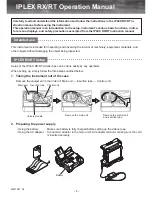
PREPARING DILUTE STANDARD SOLUTIONS
Standard solutions should be prepared to create a calibration curve.
Standard solutions can be prepared by diluting a known concentrated
standard by specified amounts. A chart or computer spreadsheet can be
created to determine the proper dilutions. Use volumetric flasks and
volumetric pipets for all dilutions.
1. In Column A – Record the maximum concentration of test as
determined by the range and path length.
2. In Column B – Record the percent of the maximum concentration
the standard solution will be.
3. In Column C – Calculate the final concentration of the diluted
standard solutions by multiplying the maximum concentration (In
Column A) by the % of maximum concentration divided by 100.
(C = A x
B
100
).
4. In Column D – Record the final volume of the diluted sample (i.e.
volume of volumetric flask).
5. In Column E – Record the concentration of the original standard.
6. In Column F – Calculate the milliliters of original standard required
(C x
D
E
= F).
A sample chart appears below:
A
B
C = A x
B
I 00
D
E
F = C x
D
E
Maximum
concentration
of test
% of
Maximum
Concentration
Final
Concentration
of Diluted
Standard
Volume of
Standard
Concentration
of Original
Standard
mL of Original
Standard
Required
10.0 ppm
90
9.0 ppm
100 mL
1000 ppm
0.90 mL
10.0 ppm
70
7.0 ppm
100 mL
1000 ppm
0.70 mL
10.0 ppm
50
5.0 ppm
100 mL
1000 ppm
0.50 mL
10.0 ppm
30
3.0 ppm
100 mL
1000 ppm
0.30 mL
10.0 ppm
10
1.0 ppm
100 mL
1000 ppm
0.10 mL
10.0 ppm
0
0 ppm
100 mL
1000 ppm
0 mL
STANDARD ADDITIONS
A common method to check the accuracy and precision of a test is by
standard additions. In this method a sample is tested to determine the
concentration of the test substance. A second sample is then “spiked” by
the addition of a known quantity of the test substance. The second
SMART COLORIMETER
13
Summary of Contents for SMART Colorimeter
Page 2: ......
















































